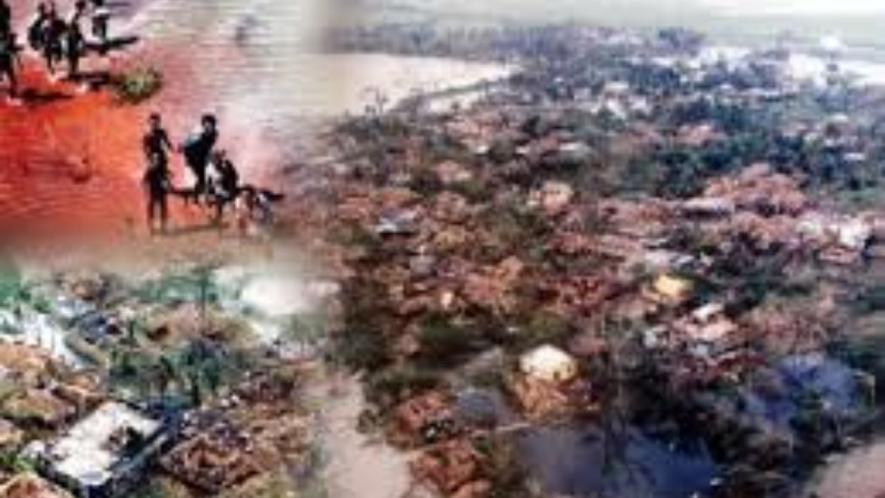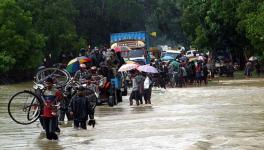Odisha: Recalling an ‘October’ Apocalypse, as Lightning Tears up Skies in Coastal Areas

It was evening and the roads were devastated when we reached Erasama in Jagatsinghpur district, where death appears to be common in the face of nature’s fury. Those who have escaped it so far, are left sobbing in pain, fear and nostalgia.
The place was desolate, with a disturbing silence reigning the atmosphere. Even the sound of gulping down water from a bottle resonated in the small room of the ‘tehsil’ office at Erasama, where we were supposed to spend the night.
Since the past few years, and uneasy calm has been looming over the Odisha coastline in October, considered the “most ominous” month.
In 1999, it was 26 hours after the devastating Super Cyclone that we reached Erasama, the eye of the storm, which nearly pulverised 14 districts of coastal Odisha pushing them 20 years behind.
As per the official statement then, over 10,000 people died and there was no count of cattle and other domestic stalk that turned the area into a carpet of corpses.
In fact, the spell of doomsday descended on Odisha on October 17, 1999 when a cyclone of lesser intensity hit parts of Ganjam district, although that was not so cataclysmic.
But, the then meteorological experts failed to assess that the October 17, 1999 incident was a precursor for the October 29, 1999 catastrophe that lasted over 36 hours, pounding anything that came its way.

This year, too, there are some similar fears as the October climate looks equally depressing and weather remains disturbingly calm.
Over the years, come October, if there is a minor ripple in the Bay of Bengal, the memories of the catastrophe stirs all kinds of memories among the people of Odisha, when a major part of the state was devastated within hours..
The Super Cyclone was an oceanic blitzkrieg that came at a speed of 260 km plus and nearly pulverised a major chunk of Jagatsinghpur in Odisha Though there were advance warning by the meteorological department, and although the communication system was not so advanced, the lack of awareness among the people and an inadequate preventive mechanism in place, resulted in a colossal damage of life and property.
On October 29, 1999, around 11 a.m, amid the worst deluge, the state suddenly went all dark. An apocalyptic oceanic storm hit Odisha, besides Myanmar and Bangladesh, with its epicentre at Erasama.
One recalls that in Bhubaneswar, the state capital, the wind speed touched nearly 150 kmph, nearly tonsuring the green capital city. Imagine the devastation in Erasama, Kujang, Padampur, Naghori, Dahibar and many more areas that were nearly consumed by the disaster and within minutes.
The core areas were shaken to the foundation and places like Dahibar, near Erasama, just vanished, its population swept away. When journalists reached Erasama on October 31, they had to negotiate through bodies strewn in the villages. Slowly, decomposition started setting in and a stench pervaded the air. The ones who escaped the wrath of nature, had no option but to weather the shock with patience for 36 hours.
History Repeated
In 1971, it was during October 26-30 that the State’s major coastal fringe in Kendrapara district experienced one of the devastating cyclones that had swept away five coastal villages, only leaving Satavaya village, which till date hangs in balance. People in the village still spend almost each night in fear of being swept by the Bay of Bengal.
In 2014, October cyclone Hud-Hud affected Andhra Pradesh and a few coastal fringes of Odisha. However, the impact was more serious in Andhra which experienced a wind speed of 185 kmph creating extensive damage there.
However, the footfall of the cyclone Phailin in 2013 on October 10, was more ominous. It had signs of intensifying into a severe cyclonic storm and had its landfall in Gopalpur in Odisha. Starting around 3 p.m, the storm unleashed a devastating furry with the wind speed crossing 215
kmph causing heavy damage in Berhampur and Chattarpur near Gopalpur. However, it subsequently weakened after a brief spell of hurricane-like fury.
In October 2024, once again, nature is giving out frightening signals about devastation in the making. Past experience has taught people to brave such calamities and this time too, they have geared up to face nature’s fury. However, this time round, the massive deforestation along the vast 480-km-long coastline can be easily blamed as a major reason behind oceanic invasions.
The writer is a freelancer based in Odisha.
Get the latest reports & analysis with people's perspective on Protests, movements & deep analytical videos, discussions of the current affairs in your Telegram app. Subscribe to NewsClick's Telegram channel & get Real-Time updates on stories, as they get published on our website.
























